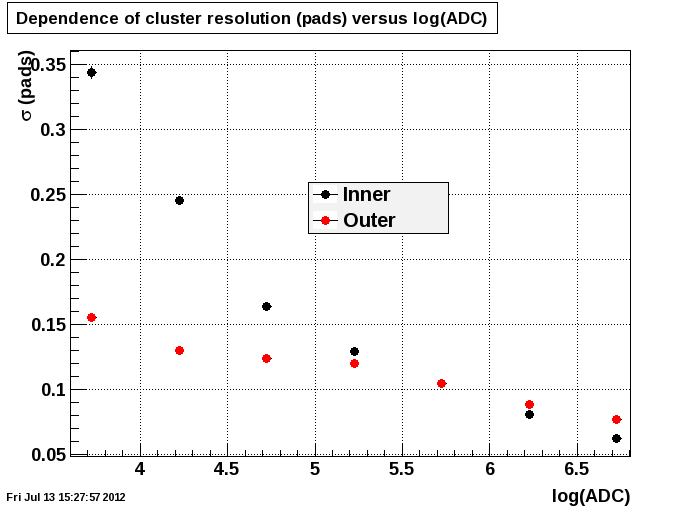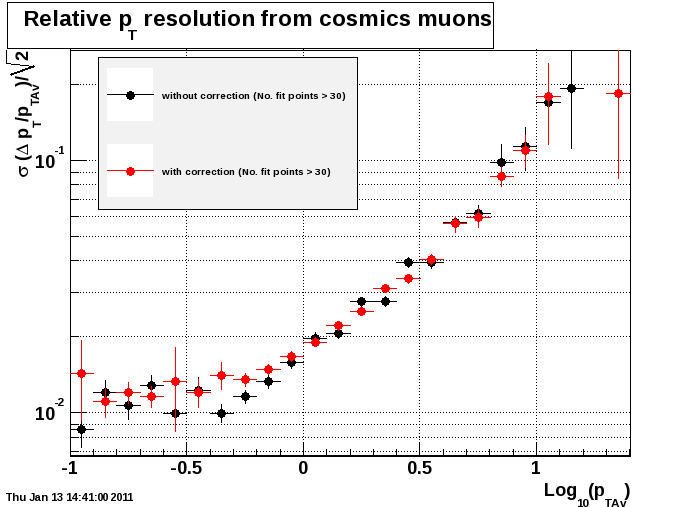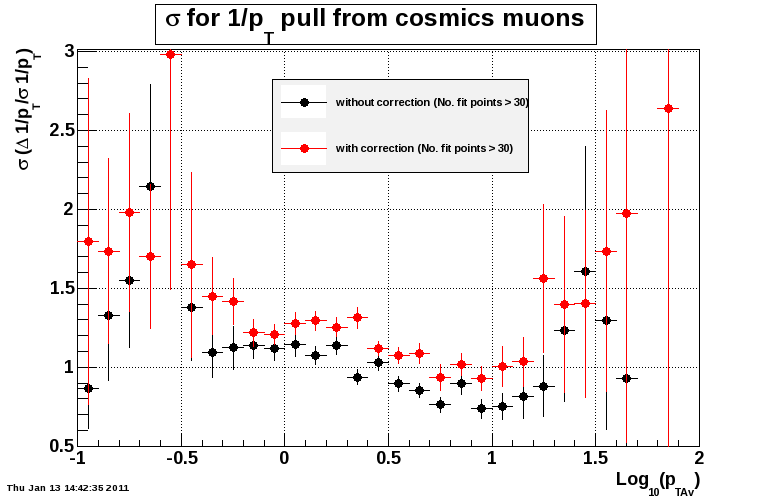- fisyak's home page
- Posts
- 2025
- 2024
- December (2)
- November (1)
- October (4)
- September (3)
- August (6)
- July (3)
- June (3)
- March (1)
- February (4)
- January (2)
- 2023
- December (2)
- November (1)
- October (2)
- September (3)
- August (3)
- July (2)
- June (4)
- April (2)
- March (2)
- February (1)
- January (2)
- 2022
- 2021
- December (2)
- October (2)
- September (1)
- August (2)
- June (3)
- May (1)
- April (2)
- March (3)
- February (5)
- January (4)
- 2020
- 2019
- 2018
- 2017
- December (3)
- October (2)
- September (1)
- August (7)
- July (3)
- May (2)
- April (1)
- February (1)
- January (2)
- 2016
- 2015
- November (1)
- October (2)
- September (4)
- August (1)
- July (1)
- June (2)
- May (4)
- April (1)
- March (1)
- February (3)
- January (1)
- 2014
- 2013
- 2012
- 2011
- 2010
- My blog
- Post new blog entry
- All blogs
Study of effect Tpc hit errors obtained from TpcRS on quality Cosmic track reconstruction (2010 data)
Gene, thank you for rephrase. Now I understood your questions.
1. About year and half ago I tried to tune Tpc hit errors using TpcRS.
From TpcRS I see that there is a rather strong dependence of position hit errors versus cluster amplitude which reflects
just signal no noise ratio dependence of these errors. (http://www.usatlas.bnl.gov/~fisyak/star/Tpc/Cosmics/padResolutionVsLogAdc.png)

2. Adding this parameterization (correction) to Sti practically did not change momentum resolution measured from cosmics.
http://www.usatlas.bnl.gov/~fisyak/star/Tpc/Cosmics/Relative_pT_Resolution.010611.png

3. It has shifted by ~20% pulls for 1/pT
http://www.usatlas.bnl.gov/~fisyak/star/Tpc/Cosmics/PullSigmaPtiVersuslog10pT.010611.png

4. I don't see the point in this "correction" because I don't see the gain. It could be that this correction will play some role
when we can account more accurately STAR dead material distribution. Other wise it looks like that this effect is washed out by others.
5. Really the question which you try to ask is : What is effect of chisq scale (lets say 20%) on reconstructed parameters ?
The answers are :
a. if this scale has influence on hit selection due to high chisq then there is no effect on fitted parameters.
b. but error estimation for these fitted parameters will be scaled by sqrt(1.+scale).
This is kind of trivial statement which you can check this by fitting straight line with ROOT TF1.
Yuri
On Jul 13, 2012, at 1:10 PM, Van Buren, Gene wrote:
Hi, Yuri
I'm not sure how to translate my question other than to add more detail...
You have stated that you found no significant momentum dependence in cosmic ray data when varying something (I've got it stuck in my mind that the "something" was strongly correlated with TPC hit errors, which in turn is directly related to chi^2). As far as I know, this absence of significant momentum dependence has not been presented (it has only been "stated"), but perhaps I am wrong and you could point us to it?
Thanks,
-Gene
On Jul 13, 2012, at 12:31 PM, Yuri Fisyak wrote:
Hi Gene, I don't understand the question. Can you translate it ?
Yuri
On Jul 13, 2012, at 11:38 AM, Van Buren, Gene wrote:
Hi, Yuri
We've discussed before presenting your study which concluded no dependence of momentum resolution on hit errors (was it more precisely no dependence on signal-to-noise of TPC hits?). This was a valuable conclusion that many people question. When will this be presented?
Thanks,
-Gene
Begin forwarded message:
From: Jan Balewski <balewski@MIT.EDU>
Date: July 13, 2012 10:42:06 AM EDT
To: "Van Buren, Gene" <gene@bnl.gov>
Cc: "Fisyak, Yuri V" <fisyak@bnl.gov>, Jerome LAURET <jlauret@bnl.gov>
Subject: Re: convergence of pp510 calibration
Hi gene,
I was assuming this response to Renee was addressing her concern about change in chi2 for reproduced 2009 FF data with changed TPC geometry. It sounded reasonable.
However, I'm asking about average chi2 of 2012 global tracks from pp510.
Here those answers are inadequate:
Maxim:
1) Since we changed the TPC hit errors one may to see changes in the
track fits and chi2 distributions.
Jan: so now you know that, then increase the assumed error in reco of pp510 top get avr chai2/dof of 1. Why not?
Maxim:
2) We do not quite control chi2 on the level better than 20%-30% when
tracking is done, so worsening of the chi2 by that amount does not
necessary mean problems in tracking.
Jan: this is not true.
You musty specify the error for each hit presented to Kalman, so you do control the error.
Kalman was designed assuming normal error distribution. 'Normal' is measured by average chi2/dof. pp510 data are presented with to small errors.
Kalman rejects few more points on the track than it should. For rapidity around 1 it cause smaller efficiency and larger error of reco PT. This implies one expects problems with tracking if chi2/dof>>1.
Maxim:
3) Model that is used to parametrize the TPC hit errors have some
issues, so it is possible that chi2 values that we get from the
tracking may have larger fluctuation for particular track geometries.
Jan: larger fluctuations do not affect the mean in the first order.
In summary, I still do not understand why you are not bothered by global average tracking chi2/dof of 1.4
Jan
On Jul 13, 2012, at 10:28 AM, Van Buren, Gene wrote:
Hi, Jan
This was a recent discussion of relevance:
http://www.star.bnl.gov/HyperNews-star/protected/get/starsoft/8696/1/2/2/2/1/1/1/2/2/2.html
-Gene
On Jul 13, 2012, at 9:37 AM, Jan Balewski wrote:
Hi,
is it a taboo?
Jan
On Jul 2, 2012, at 2:24 PM, Jan Balewski wrote:
Finally, I restate my other concern - somehow lost in the discussion.
Question: why average chi2/dof for global tracks is not 1.0 (it is rather 1.4)?
For pp5100 2012 data
It should be 1.0. What are you going to to about it?
It is *independent* from observed change of calibration with luminosity.
- fisyak's blog
- Login or register to post comments
